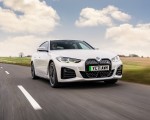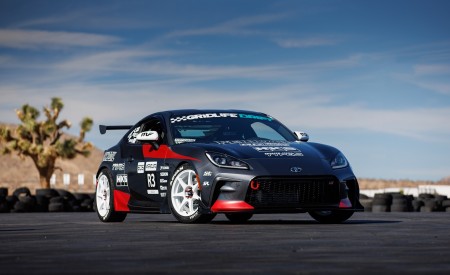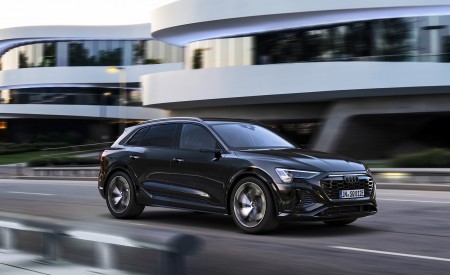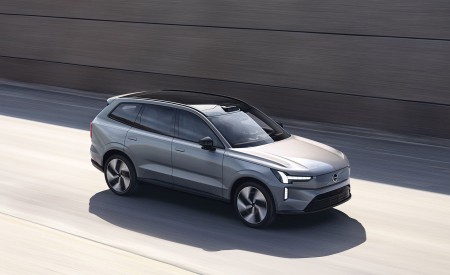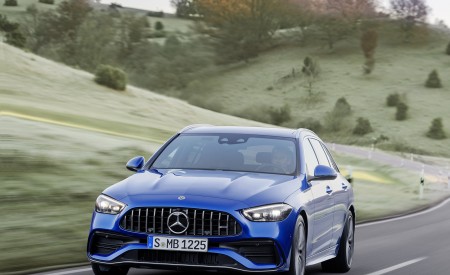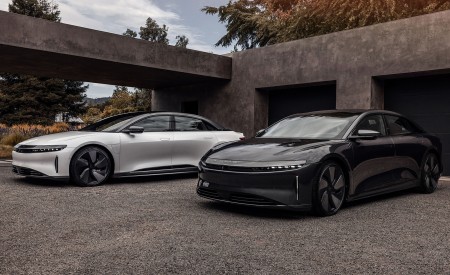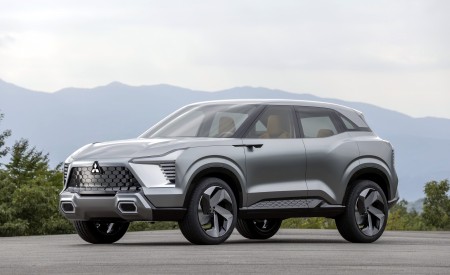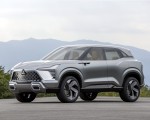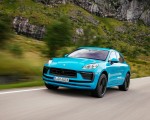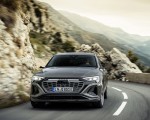2023 BMW i4 eDrive40 (UK-Spec)
BMW announced the newest additions to the BMW i brand, the i4 eDrive40 and i4 M50 models. The i4 M50 is the first fully-electric performance model to come from BMW M GmbH. The i4 blends the functionality and space of the gran coupe design with the instantaneous power delivery of BMW's latest 5th generation eDrive. Class-leading driving dynamics and long-distance comfort, elegant design, uncompromising workmanship, cutting-edge user-vehicle interface and advanced infotainment and driving assistance technologies all combine to deliver a zero-emissions BMW worthy of the Ultimate Driving Machine moniker.
Power is provided by BMW's latest 5th generation eDrive technology which combines the electric motors, power electronics, charging system and high-voltage battery. The electric motor, power electronics and transmission share one compact housing while the high-voltage battery measures only 4.3-inches in height and is mounted low in the floor of the new i4 for improved vehicle agility.
BMW Group has been producing battery modules and high-voltage batteries since 2013 and this in-house experience shows, with the latest generation of batteries, found in the i4, having a maximum DC fast charging capacity of up to 200 kW and AC Level 2 charging of up to 11 kW.
Sustainability and Reduced Carbon Footprint
Sustainability is an integral part of the development of the new BMW i4, from the sourcing of materials to the production of the i4 itself and to the recycling of its components in the future. Every step of the value chain was carefully looked at to reduce the carbon footprint of the i4 to the absolutely lowest level possible.
Steps taken by the BMW Group include commitments from all battery cell suppliers for 5thgeneration BMW eDrive technology to only use electricity from renewable sources. The aluminum electric motor cases are manufactured from purely green energy. Only locally-generated hydroelectric power is used for the i4's production at BMW Group Plant Munich.
Monitored Raw Materials Sourcing
The high-voltage NMC-811 batteries in the BMW i4 contain less than 10 percent cobalt content. In addition, the BMW Group procures the required cobalt for its battery cell production itself and then makes it available to the battery cell suppliers. The lithium required for battery cell production is likewise obtained under transparent conditions that are monitored by the BMW Group. The BMW Group sources the lithium used in the high-voltage battery pack on board the BMW i4 from hard-rock deposits in Australia and passes it on to the battery cell makers. The company can therefore ensure that environmental and sustainability standards are observed during the extraction and processing of cobalt and lithium and that there are no violations of human rights.
The electric motors for the BMW i4 are made without the use of rare earth materials, allowing the BMW Group to not be reliant on their availability. The proportion of secondary aluminum used in the i4 helps to make manufacturing more sustainable. Targeted use of recycling methods for this high-grade lightweight metal can lead to a substantial reduction in the energy-intensive use of primary aluminum, which also generates high levels of CO2 emissions when conventional manufacturing techniques are employed. Besides this, recycled plastics are used in many i4 components.
Driving Dynamics
The ingredients which make up the experience of driving a BMW include instantaneous power delivery, excellent traction and directional stability, neutral steering behaviour, precisely controllable handling even under maximum lateral acceleration, superb stopping power and an excellent balance between sportiness and ride comfort in everyday driving and on long trips alike. The new BMW i4 delivers all these attributes with zero tailpipe emissions. The 5th generation eDrive technology offers instant torque-on-demand while the location of the high-voltage battery low in the vehicle's floor reduces center of gravity for improved handling.
Thanks to the battery module, the i4's center of gravity is 1.3-inches (BMW i4 M50) or 2.1-inches (BMW i4 eDrive40) lower than on a 3-Series Sedan.
The rigid body structure and sophisticated chassis design impart superb agility, especially for the new i4 M50, the first purely electric performance model from BMW M GmbH.
Chassis technology includes lift-related shock absorbers, rear air suspension, electromechanical steering with Servotronic function, integrated braking system, DSC (Dynamic Stability Control) system and near-actuator wheel slip limitation. The BMW i4 M50 boasts fully-electric all-wheel drive, adaptive M suspension with individually configured springs and shocks, specially designed anti-roll bars and an additional spring strut tower brace in the front end, along with variable sport steering, M Sport brakes and M light-alloy wheels up to 20 inches in diameter with mixed-size tires.
The development teams at the BMW Group and BMW M GmbH harnessed their immense expertise, acquired over many decades of work, for the i4's fine-tuning. An intensive program of testing was carried out at BMW Group's test sites in Miramas in southern France and Arjeplog in the north of Sweden to make sure that motor output, power transmission, chassis set-up and body attributes created a compelling driving package.
Electric All-Wheel Drive, Wheel Slip Limitation and Launch Control
With an electric motor at both ends, the new i4 M50 features an electric all-wheel drive system which increases traction in all road conditions, and which can optimize traction and handling stability by adjusting the drive torque, without the need for traction control intervention.
The fully variable system can choose the exact needed split, from highly efficient pure rear-wheel drive to all-wheel-drive for maximum traction. Normally, drive power is relayed solely to the i4 M50's rear wheels to increase its efficiency and range. At higher levels of lateral acceleration or in response to wheel slip, the motor acting on the front wheels assumes the required drive power delivery to optimize driving dynamics and directional stability.
The BMW-developed near-actuator wheel slip limitation, which in combination with the electric all-wheel drive, enables the car to maintain optimum traction in a straight line. Specially configured for the instantaneous power delivery of electric motors, this traction control system is integrated into the motor management. This eliminates the long signal paths to the control unit for the DSC (Dynamic Stability Control), meaning that the corrective inputs are applied up to ten times faster than in conventional systems.
Near-actuator wheel slip limitation is fitted on both the rear-wheel-drive BMW i4 eDrive40 and the all-wheel-drive BMW i4 M50. The near-actuator wheel slip limitation is designed to bring the advantages of rear-wheel drive to the world of electric mobility in the BMW i4 eDrive40, whereas in the BMW i4 M50 it is set up for optimum, rear-biased distribution of drive torque between the two axles.
A Launch Control function is included in the new BMW i4. Activating it allows the driver to accelerate with optimum traction with the accelerator pressed to the floor. Torque oscillations when stationary indicate that the drive system is ready for 'launch', at which point the full combined output is instantly made available.
Rigid Body Structure and Chassis
A rigid body structure is paramount to excellent handling and comfort. The BMW i4 integrates the high-voltage battery into the body structure to further increase its torsional rigidity. The high-voltage battery pack is joined to the floor assembly by means of 22 bolts, while the battery enclosure is also directly connected to the front axle subframe.
The BMW i4 comes with a bracing package for enhancing body rigidity at the rear and with integral shock tower-to-front end struts at the front, where an aluminum shear panel combines with the high-voltage battery housing to form a load-bearing structural element offering even greater rigidity. In order to deliver the extra-sharp driving dynamics expected of the BMW i4 M50, an additional brace is fitted between the two strut towers that helps to give the BMW M model its greater steering precision.
The double-joint spring strut front axle has swivel bearings and control arms made from aluminum, with the resulting reduction in weight improving shock response on uneven road surfaces. Axle kinematics, track width and camber have all been specially configured to increase steering precision and the absorption of lateral forces when during lateral acceleration. The model-specific elastokinematics help to ensure precise wheel guidance and increase primary ride comfort. This includes using a hydraulically damped torque strut bearing to reduce oscillation and vibration. The BMW i4 M50 also features an elastic bearing for the front drive unit in the front axle subframe that helps increase acoustic isolation from the body.
The rear five-link rear axle features control arms in an innovative sheet-steel construction together with aluminum wheel hubs and upper wishbones to reduce unsprung mass. Rear axle torsion-resistant control arms and model-specific elastokinematics contribute to precise wheel guidance. The electric motor's dual elastic bearing is completely integrated into the rear axle subframe, combining with the subframe's large supporting base to provide effective acoustic isolation.
Accurate Steering: Servotronic or Variable Sport
The structural rigidity of the body and chassis mountings provides for sharp turn-in response and great cornering dynamics. The electromechanical steering delivers excellent directional accuracy and low sensitivity to disruptive forces from uneven road surfaces. It always offers the driver accurate feedback and is free of torque steer, even during sharp acceleration or deceleration. The standard Servotronic speed-sensitive power assistance offers two settings – one very direct and one more comfortable – that form part of the overall vehicle set-up activated by the driver using the Driving Experience Control switch.
Variable sport steering, which is optional on the BMW i4 eDrive40 and standard on the BMW i4 M50 combines the Servotronic function with a speed dependent variable rack ratio which makes the car nimbler when parking while increasing agility at moderate speeds and steering stability at higher speeds.
Lift-Related Shocks, Rear Air-Suspension and Adaptive M Suspension
Steering is not the only system which affects straight-line poise and cornering stability, however. Carefully matching the steering with the spring and shock tuning, gives the new i4 its balanced feel of performance and comfort.
The BMW i4 is equipped with standard lift-related shock system that generates linear damper force according to the changing spring travel, resulting in improved damping response. Body movement is noticeably reduced along with vibrations caused by bumpy road surfaces. Extra hydraulic damping on rebound at both the front and rear axle prevents excessive body dive when driving over large bumps.
The optional adaptive M suspension (standard in the BMW i4 M50) allows the driver to adjust the shock setting to suit the driving situation and their personal preferences. The front and rear shocks are controlled electronically and individually for each wheel. This increases agility and body stability during cornering, while also enhancing ride comfort. Damping force is adapted by means of continuously adjustable valves, which are controlled to adjust force as required in just a few milliseconds after factoring in longitudinal and lateral acceleration, vehicle speed, steering angle, body acceleration and wheel acceleration at the front axle.
Both i4 models also include a rear air suspension, whose automatic self-levelling feature keeps the car at a constant ride height when carrying a heavy load. The air suspension has been configured to increase ride comfort and sharpen handling abilities by greatly reducing body pitch and roll.
Integrated Braking System
The integrated braking system helps to eliminate unwanted pedal feedback during brake regeneration. It enables Brake Energy Regeneration at a maximum rate of 195 kW on the i4 M50 and 116 kW on the i4 eDrive40, thereby boosting efficiency and range. Thanks to the cutting-edge technology, the brake activation, brake booster and braking control functions are combined in a compact module. The required brake pressure is triggered using an electric actuator, an operating principle that generates pressure more dynamically and ensures significantly faster and more precise interventions from the driving stability control system. The integrated braking system generates stopping power adjusted precisely to the driver's inputs, while producing consistent pedal feel unimpaired by any pulsing as a result of wet road surfaces, significant lateral acceleration or high brake temperatures.
Light Alloy Wheels and More Advanced TPM System
The BMW i4 eDrive40 is fitted with standard 18-inch light-alloy wheels while 19-inch wheels are optional. The BMW i4 M50 includes 19-inch M light-alloy wheels with mixed-size tires. Additional 19-inch and 20-inch wheels are optional.
A more advanced version of BMW's standard Tire Pressure Monitor is found on the i4. The system's sensors relay data on tire pressure and temperature for each individual wheel, which is then processed to generate corresponding readouts in the Control Display. The Tire Pressure Monitor also factors in specific data on the tires fitted, including manufacturer, dimensions and production date, which can now for the first time be scanned from a QR code at the factory or service partner. Exclusive to BMW, this system simplifies use of the tire pressure indicator in the iDrive menu. In the menu item for tire selection, the driver has only to indicate whether the vehicle is partially or fully laden to view information on both the ideal and current tire pressures and decide whether there is any need to adjust them.
A digital tire diagnosis function helps advise the owner of tire wear by processing the data from the Tire Pressure Monitor in the BMW backend together with the pressure, temperature and wheel speed readings to forecast the remaining tire life. Customers can be notified via the My BMW App, for example, if action needs to be taken.
Intelligent Lightweight Design and Optimized Aerodynamics
Intelligent lightweight design of the body and chassis allow both the weight and the functional properties of the relevant components to be optimized for superior rigidity and crash safety. The BMW i4 uses an engine side member made from extruded aluminum and die-cast aluminum spring struts. The hood and front fenders are made of aluminum. The exceptionally rigid passenger cell is built from hot-stamped steels and aluminum alloys.
The excellent aerodynamic attributes of the i4 deliver drag coefficient (Cd) of just 0.24 for the i4 eDrive40 and 0.25 for the i4 M50. All areas of the body have been crafted according to aerodynamic principles, from the front bumper to the exterior mirrors to the tailgate's integral spoiler lip. The high-voltage battery housing, the motor compartment shielding and the cover for the torsion struts form a continuous surface with seamless transitions to improve air flow along the underbody. Other measures include a front spoiler, air guides in front of the wheels, embedded channels that optimize airflow and cover panels for the rear axle and diffuser. The i4's specially designed lightweight rear diffuser is made from textile-based raw materials and helps to both reduce weight and direct the airflow more efficiently.
Active air flap control at the bottom of the otherwise completely blocked off BMW kidney grille reduces the car's aerodynamic drag even further. The flaps can be adjusted in ten stages, allowing cooling air to be supplied to the drive system, high-voltage battery, brakes and air conditioning system in precise quantities. Air Curtains at the outer edges of the front bumper guide the oncoming air along the wheels. The standard light-alloy wheels feature an aerodynamically optimized design. There is also the option of BMW Individual aerodynamic wheels with inserts between the spokes whose flat design ensures a far smoother airflow.
Rare Earth Material-Free Electric Motors
The BMW i4 features one electrically excited synchronous motor driving the rear axle on the i4 eDrive40 and two motors, driving both the front and rear axles, on the i4 M50. The drive system's high efficiency and cutting-edge NMC-811 battery cell technology give the car a long operating range and exceptional everyday usability. The extremely powerful charging technology is capable of 200 kW charging capacity for high-power DC charging.
The BMW i4 M50 is powered by a front 255 hp electric motor and a rear 308 hp motor, which together put a combined maximum output of 536 hp. The single rear electric motor in the BMW i4 eDrive40 delivers 335 hp. Power and torque is transmitted to the respective drive axle via a one-speed transmission which is contained in the same compact housing as the electric motor. The electric motors developed in-house by the BMW Group have an efficiency factor of 93 percent, bettering the efficiency figures achieved by current combustion engines of less than 40 percent.
The excitation of the rotor in the BMW i4 motors is not induced by fixed permanent magnets, but the feed-in of electric energy. This allows the use of critical rare earth metals (required for magnetic components) to be avoided altogether in the manufacture of the rotor.
Sport Boost Function for the i4 M50
A specially designed boost function that can be activated on demand by the driver is available whenever SPORT mode is engaged and is used to unleash the maximum output of both motors for quickest acceleration. The Sport Boost function increases the system's combined drive power by 67 hp to its maximum of 536 hp for over ten seconds. At the same time, combined torque is upped by 48 lb-ft to 586 lb-ft. The extra burst of acceleration is accompanied by an M-specific soundtrack.
To allow maximum power to be summoned in situations where the car's performance capabilities are being really put to the test, the Sport Boost function can be activated several times in succession if the high-voltage battery has enough charge. Every time the driver accelerates, a fuel gauge-style icon in the instrument cluster shows how much extra power is available and for how long.
Adaptive Energy Recuperation
Adaptive and individually regulated recuperation means the intensity of the brake energy recuperation can be adapted to the road situation, as detected by data from the navigation system and the sensors used by the driver assistance systems. Just before reaching a turn, a traffic light at a junction or a section of road with a lower speed limit, for example, a very high level of recuperation will be activated as soon as the driver releases the accelerator. When approaching a vehicle ahead, the drive unit will again switch over to the generator function in order to feed energy back into the high-voltage battery. When combined with an anticipatory style of driving, adaptive recuperation allows more than 90 percent of all deceleration to be performed using Brake Energy Regeneration alone, without any need to trouble the braking system.
On the open road, the coasting function enhances comfort and efficiency with no drive power whenever the driver eases off the accelerator. Adaptive adjustments according to the driving situation are carried out when the navigation system's route guidance function is not activated, precise control of recuperation enabling instantaneous responses to changes in the situation. If the i4 approaches closer to a vehicle ahead while coasting, for example, recuperation will be initiated immediately to slow the car down.
Adaptive recuperation is one of the standard settings activated when the driving position D is engaged using the selector lever on the centre console. Alternatively, the driver can choose a high, medium or low Brake Energy Regeneration setting for all driving situations in the iDrive menu. Maximum recuperation power is 116 kW in the BMW i4 eDrive40 and 195 kW in the BMW i4 M50. In driving position D, the new BMW i4 pulls away at minimal speed as soon as the brake pedal is released, increasing comfort when maneuvering and in stop-start traffic. And activating driving position B with the selector lever utilizes the maximum amount of recuperation available every time the driver eases off the accelerator. This allows the BMW i4 to be driven in urban traffic with virtually no use of the brake pedal. Besides generating the one-pedal feeling characteristic of the BMW Group's electric vehicles, this intense level of recuperation also lends itself to very sporty driving with frequent quick switches between accelerating and decelerating.
Graphics showing the driving status and energy flow can be called up in the BMW iDrive system's Live Vehicle menu. When either the COMFORT or ECO PRO modes have been selected with the Driving Experience Control switch, the control display clearly indicates whether the drive system in the BMW i4 is currently providing propulsive power, recuperating brake energy to feed it back into the high-voltage battery or has been de-energized / switched to torque-neutral during a coasting phase. Additional information is also shown to the driver whenever adaptive recuperation is used to slow down the vehicle. The driving style analysis that also appears in the control display encourages drivers to drive as efficiently as possible with its evaluations of acceleration style and anticipatory use of the accelerator.
High-Voltage Battery
The 5th generation BMW eDrive technology includes a high-voltage battery with state-of-the-art battery cell technology. Volumetric energy density at cell level is up by 40 percent compared to the battery in the current BMW i3 (MY 2020). And the latest generation of high-voltage batteries display excellent qualities when it comes to performance capability, charging and discharging, durability and safety.
The 5th generation BMW eDrive high-voltage batteries are particularly suited to reuse of their raw materials as part of a circular approach. The materials used in them and their design result in a recycling rate of up to 90 percent.
The high-voltage battery in the i4 is comprised of four modules with 72 cells each and three 12-cell modules. Together they provide a net energy content of 83.9 kWh gross and 81.5 kWh net. This allows the BMW i4 eDrive40 to deliver an estimated range of around 300 miles and the i4 M50 an estimated range of 245 miles.
Integrated Heating and Cooling System with Heat Pump Function
The BMW i4 is equipped with a standard integrated heating and cooling system for the cabin, together with its high-voltage battery and its drive system that operates using an exceptionally efficient heat pump function. The system comprises three cooling/heating circuits that can be interconnected by means of electric valves with a shared expansion tank. While driving at low outside temperatures, the excess heat generated by the drive units is used to warm up the high-voltage battery. The highly integrated version of the heat pump developed by BMW uses up to 75 percent less energy than the system in the current BMW i3 (MY 2020). A two-level cooling module, a refrigerant compressor, two evaporators, a water-cooled condenser and a high-performance control unit together ensure optimum temperature control for both the BMW eDrive components and the vehicle interior in any operating state and in all regular weather conditions. At extremely low ambient temperatures, the heat pump is assisted by a pair of powerful continuous-flow heaters offering 9 kW of heating power each. This ensures that thermal comfort on a par with conventionally powered BMW models can be provided very efficiently in any situation. The latest version of the heat pump makes use of ambient heat and heat from dehumidification – as well as the waste heat from the motors – for energy-efficient operation.
The integrated heating and cooling system also insures optimal temperature control for the high-voltage battery in highly dynamic driving situations with high power requirements and when rapid-charging from a DC charging station. If the navigation system's route guidance function is active and has scheduled a stop for the BMW i4 at a fast-charging station, anticipatory thermal management will automatically pre-condition the battery beforehand. Warming up the high-voltage battery or cooling it down as appropriate means it will be at the optimum temperature for quick and efficient charging at maximum capacity upon arrival at the charging station. Thermal management takes several factors into account here, including current battery temperature, remaining range, the predicted charging rate and the amount of electricity due to be fed to the battery according to the overall route calculation.
High-Speed Charging at up to 200 kW
The Combined Charging Unit (CCU) in the BMW i4 enables an extremely high level of flexibility when it comes to using charging stations. Hooking up the high-voltage battery to a Level 2 Wallbox allows it to be fed with AC power at a charging rate of up to 11 kW. Using this method, the BMW i4 can recharge its battery from totally empty to 100 per cent in under 8.0 hours.
A significantly higher charging output with shorter charging times can be accessed by using a DC fast-charging station. The BMW i4 can charge its high-voltage battery there at up to 200 kW. When hooked up to high-power charging station of the type, the i4 can take enough energy on board in just ten minutes to increase range by up to 90 miles.
Charging with EVgo
Recognizing the critical importance of public charging infrastructure to EV drivers, BMW has partnered with EVgo, the nation's largest public fast charging network and the first in the US to be powered by 100% renewable energy. BMW Charging Powered by EVgo provides BMW EV and PHEV drivers with access to EVgo and partner charging network stations via an easy to use mobile app, underscoring BMW's commitment to a high performance and zero emissions driving experience. BMW Charging Powered by EVgo enables BMW drivers to see real-time status of chargers, initiate a session, check their account status, and more all within the BMW Charging Powered by EVgo mobile app.
EVgo and BMW previously partnered on the ChargeNow DC Fast Program and are building on their shared history to accelerate the transition to electric vehicles. EVgo's public fast charging network offers the convenience of charging at more than 800 fast charging locations at retail and grocery stores, shopping malls, entertainment centers and other sites ideal for quick, 20-30-minute errands. Plus, for drivers who will be parked for a few hours, EVgo's relationships with partner networks will provide access to more than 38,000 L2 chargers for drivers, expanding the variety of charging options. With the new BMW Charging Powered by EVgo partnership, buyers and lessees of qualifying fully electric BMW models will receive $100 in EVgo charging credit that can be used at EVgo and partner network stations across all 50 states.
Exterior Design
The BMW i4 combines the hallmark sporting aesthetic of the brand's coupés with the comfort of a four-door car and a practical appeal offered by the large tailgate. The elegantly stretched proportions of the new BMW i4, the short overhangs, slim pillars, doors with frameless windows and a roofline that flows smoothly into the rear underscore a silhouette that very much fits the BMW coupé mould.
At the heart of the front end stands the striking, BMW kidney grille, which is largely blocked off due to the small amount of cooling air required by the electric drive components. Depending on the specification, the car's front camera is joined by ultrasonic and radar sensors integrated discreetly into the surface of the kidney grille. The front bumper of the BMW i4 also has only a small number of openings. These include the air curtains positioned towards its outer edges, which direct air efficiently past the wheels. Clearly designed surfaces painted almost entirely in body color, precise lines and black inlays underline the modern, function-led character of the front end.
With their reduced and technically sophisticated appearance, the slim headlights of the BMW i4 fit in neatly with the surface design of the BMW kidney grille. The classical twin-headlight layout is enhanced by the addition of modern and minimalist U-shaped light elements for the daytime driving lights. The BMW i4 is equipped with standard full-LED headlights.
Large and smooth sculpted surfaces, the air breathers integrated into the side sill trim on the front fenders, flush-fitted door handles and the fin-like trailing edge of the passenger compartment mark out the aerodynamically optimized design of the BMW i4 when viewed from the side. The elegant stretched side window design flows into the Hofmeister kink counter-swing above the powerful shoulders north of the rear wheels.
As an exhaust system is not required, the lower section of the rear bumper is used to improve aerodynamics via the diffuser element. Below the long and slim, L-shaped rear lights with their highly technical design is an extremely clear surface treatment. Sharply cut vertical aero vanes frame the rear of the car to the sides. The lower areas of the skirts and rear have a sophisticated black finish, giving the car a lower-slung appearance and accentuating its broad stance. The backup assist camera is integrated into the BMW badge on the tailgate.
Model-specific design features give the BMW i4 M50 eye-catching looks to differentiate its more sporting character. The front bumper has the signature U-shaped design of BMW M models. Additional side air intakes optimize brake cooling. The BMW kidney grille surround and the vertical trim around the air curtains come in Cerium Grey as do the exterior mirror caps and the inlays in the outer edges of the rear bumper, while the air breathers, the side sill trim strips and rear bumper trim are painted in high-gloss black. An M-specific spoiler on the tailgate rounds off the distinctive, performance-oriented appearance of the BMW i4 M50.
Interior Driver-Focused Cockpit with BMW Curved Display
The interior of the BMW i4 fuses the clear design language and modern premium ambience with an extremely progressive approach to driver-focused cockpit design. The purely electric gran coupé comes with a very slim and low instrument panel, which provides the stage for the latest version of the fully digital display grouping. The innovative BMW Curved Display brings together the information display behind the steering wheel and the control display of the BMW iDrive control/operation system into a frameless, single-piece glass surface angled towards the driver. The 12.3-inch information display and 14.9-inch control display effectively merge into a single driver-focused unit.
The BMW Curved Display in the BMW i4 is held in place by a supporting structure that is concealed from the occupants' view and appears to be free standing in the cockpit. The anti-reflective glass used makes it possible to dispense with the customary binnacle for shielding the readouts from sunlight, giving the cockpit area a remarkably tidy and airy appearance.
The rest of the interior design is focused towards providing a richly involving driving experience. The BMW i4 is fitted with standard sport seats and a sports steering wheel with multifunction buttons. The high center console and flowing surface structure running from the instrument panel into the door panels generate a cocoon-like feel in the front compartment. In the BMW i4 M50, soft, raised knee pads on the center console further accentuate the car's engaging driving character.
Thoughtfully designed surfaces, premium materials and precision workmanship are key ingredients in the interior's ambience. The Start/Stop button for the drive system is positioned in the control panel in the center console, which also houses the BMW Controller and the buttons for the Driving Experience Control unit and electromechanical parking brake alongside the model-specific gearshift lever. Blue accents on the Start/Stop button, steering wheel and gearshift lever are a nod to the electric drive system.
Automatic Climate Control with New Controls and Integral Nanofiber Filter
The BMW i4 is equipped with a standard three-zone automatic climate control. It allows the driver, the front passenger and the rear-seat passengers to set their desired temperature and ventilation levels individually. The driver and front passenger can adjust the climate control system to their personal preferences via the control display or by voice command. Depending on the settings selected in the climate control menu, changing the temperature also prompts adjustment of the seat heating and seat ventilation control. This means individual functions no longer must be operated separately by the user. Moreover, those on board can see immediately if the system is currently cooling or heating the interior and if the seat heating or seat ventilation is activated.
The system also considers the number of passengers on board and where they are sitting. This is the first time all the vehicle's temperature and comfort-enhancing functions have been controlled from a single source.
Cutting-edge nanofiber filter technology is used to purify the air inside the car more effectively, with nano-fleece and activated carbon layers further improving air quality in the interior. Nanofiber filter technology enables ultrafine dust particles and certain micro-bacterial particles and allergens to be kept out of the cabin. The pre-heating or pre-conditioning function allows the interior air to be purified effectively before the customer climbs aboard.
A pre-heating and pre-conditioning function is included in the BMW i4. This is activated through iDrive, or by smartphone via the My BMW app.
High Level of Acoustic Comfort, Large Glass Slide/Tilt Sunroof
The BMW i4 is fitted with standard acoustic glazing for the windshield. An automatically dimming rear-view mirror and heated exterior mirrors. The standard glass slide/tilt sunroof with a transparent surface measuring 3.6-square feet baths the interior in light. The 34.1-inch wide and 23-inch long expanse of glass extends into the rear of the car and includes a front panel which can be opened or tilted up.
Personalized Light Moods and Audio Experience
The standard LED lighting for the cabin includes reading and interior lights in both the front and rear, as well as lighting for the glove compartment, the storage compartment under the center armrest, the footwells, the mirrors in the sun visors and the boot, plus the courtesy lights in the doors. The optional ambient lighting provides atmospherically rich illumination of the interior with precisely positioned LED fiber-optic light guides for the contour lines in the instrument panel and the door panelling. The lighting's distribution, brightness and color scheme can be configured in the iDrive menu. This option also includes the Welcome Light Carpet for the approach to the doors and the Dynamic interior light function, whose pulsating light signals indicate an incoming phone call or an open door when the engine is running.
The standard BMW Live Cockpit Professional fitted as standard in the BMW i4 includes an audio system with ten speakers and a 205-watt amplifier. The Harman Kardon surround sound system, complete with 16 speakers and a digital seven-channel amplifier delivering 464 watts of audio power is optional.
Acoustic Pedestrian Protection and BMW IconicSounds Electric
The electric drive system powering the BMW i4 produces not only zero local emissions but also almost nothing in the way of sound. In order to alert other road users that the i4 is approaching, it comes standard with an acoustic pedestrian protection system. Developed specially for electrified BMW vehicles, artificially generated and emitted through exterior speakers, the sound is active up to driving speeds of 19 mph. It gives the vehicle a brand-typical soundtrack, without impinging on the comfort of those on board.
An unmistakable, model-specific acoustic experience can also be enjoyed in the interior of the BMW i4. Pressing the Start/Stop button sparks an inspiring acoustic accompaniment that builds anticipation for the all-electric driving experience to come. This sound production was created as part of a collaboration between film music composer and Academy Award winner Hans Zimmer and Creative Director Sound at the BMW Group Renzo Vitale. When underway, a drive sound developing a strikingly transparent timbre with spherical components delivers authentic feedback to every movement of the accelerator. The character of the sound alters according to the vehicle setting chosen with the Driving Experience Control switch. This means that in SPORT mode the car's aural spectrum is more dominant and powerful. Drive system processes are registered within milliseconds and acceleration, load changes or recuperation given a suitable acoustic accompaniment. The drive sound developed for the BMW i4 M50 stands out with its particularly energy-charged tone. Movements of the accelerator are accompanied by a less harmonious but enticingly stirring and technical sound. Added to which, the acoustic differentiation between COMFORT and SPORT mode is extremely clear.
BMW iDrive 8
The new BMW iDrive 8, a new generation of displays, controls and software, plus extremely powerful connectivity and data processing give the BMW i4 all the tools needed to serve as an intelligent and proactive partner in any situation. The intuitive, multimodal operation is turned into a natural dialogue between the user and their car that seeks to precisely tailor all the functions controlled via BMW iDrive to the driver's needs and preferences as the situation demands.
The new BMW iDrive was designed with a focus on dialogue-based interaction using natural language and on touch operation. Consequently, new available features include the expanded capabilities of the BMW Intelligent Personal Assistant, which uses a new graphic to communicate with the vehicle's occupants, and the BMW Curved Display – the all-new fully digital display grouping in the BMW i4 formed by the information display and control display and angled towards the driver.
Natural Dialogue with the BMW Intelligent Personal Assistant
The new generation of BMW iDrive sees the BMW Intelligent Personal Assistant gaining additional skills to strengthen the personal relationship between the digital companion and the car's occupants.
In communication between people, a lot of information is conveyed non-verbally. The Assistant's new visualisation approach, featuring spheres of light in different sizes and brightness levels, gives it more space and forms of expression. This provides it with a clearly visible focal point and recognizable states of activity.
When the user speaks to the Assistant, it appears in a fluid animation and spreads out engagingly over the displays. The BMW Intelligent Personal Assistant can distinguish who is talking to it and appears on the relevant screen area. A widget designed especially for the BMW Intelligent Personal Assistant enables rapid access to other settings and suggestions.
Advances have also been made in the functionality of the BMW Intelligent Personal Assistant. An expanded pool of underlying data and information has not only made the digital assistant more intelligent; it has also enabled it to act proactively according to context. The BMW Intelligent Personal Assistant suggests functions the customer has not yet tried out. For example, if the driver regularly opens the window at a certain point, the Assistant recognizes the pattern and proactively suggests setting the relevant GPS coordinates – e.g. the entrance to a car park where a parking ticket needs to be retrieved – as an automatic opening point for the window.
BMW Head-Up Display
In the BMW i4, the customary BMW driver focus follows the innovative principle "Act, Locate and Inform". The new BMW iDrive enables the screens in the BMW Curved Display and new 3+ generation BMW Head-Up Display to dovetail with one another more precisely than ever. For example, the driver is always given the relevant information where they can absorb it as quickly and easily as possible. When using the navigation system, for example, the Control Display provides a large map view (Inform), while on the display behind the steering wheel, current positioning information (Locate) can be shown in the form of a map excerpt. The driver is given specific instructions in the Head-Up Display (Act) in the form of lane recommendations or information on the distance to a junction where they need to turn off.
The driver can adapt the type and amount of content shown in the Head-Up Display to their personal preferences or the traffic situation at hand at any time. They can choose from various views focusing on a variety of content areas, e.g. navigation or driver assistance. A knurled wheel on the right-hand spoke of the multifunction steering wheel enables fast and intuitive selection of the desired view.
Remote Software Upgrade
The new BMW iDrive 8 further enhances updating the in-car software. New and improved functions can be imported quickly and easily over the air, either using the car's built-in SIM card or via the My BMW App. Installation is subsequently launched by the customer and seldom takes longer than 20 minutes. Remote Software Upgrades are installed free of charge.
The driver is alerted to the availability of a new upgrade either in the Control Display (if the car is parked) or in the My BMW App on their smartphone. In the BMW i4 the BMW Intelligent Personal Assistant now also issues a reminder that the new software is available by means of a special widget. Also new is the option for the driver to schedule the installation process. Here, the vehicle must first be securely parked in accordance with the instructions. Installation can then be carried out automatically at a pre-set time – meaning it can be done overnight as well.
Personalisation with BMW ID
When interacting with the new BMW iDrive, BMW i4 customers benefit from increasing personalization of the user experience based on the BMW ID. This is used for securely storing even more personalized settings and transferring them between vehicles. A PIN code can be created for the BMW ID associated with a specific key to prevent other vehicle users from accessing personal data.
When signing into a vehicle for the first time, simply scanning a QR code is all it takes to create a new BMW ID on a smartphone. If the user uses the My BMW App and is therefore already in possession of a BMW ID, this will be automatically imported into the car via the app when the QR code is scanned.
The BMW ID can be created and activated effortlessly and securely in vehicles with BMW iDrive 8 or BMW iDrive 7. Once the BMW ID has been imported, the driver will receive a personal greeting which will include the customized profile image the driver can create in the My BMW App. At the same time, personal settings for seat and steering wheel position, exterior mirrors, navigation system, driver assistance functions, display layouts, shortcuts and favourites as well as infotainment system settings will be imported automatically. Personalized suggestions from the BMW Intelligent Personal Assistant are also stored in the BMW ID, together with individually selected wake words and privacy settings. Once the BMW ID has been activated with the associated key or by selecting the BMW ID in the vehicle, the personal settings are instantly adopted. The customer can elect to save these personal settings to the BMW Cloud.
Creating a BMW ID is essential for using the new BMW iDrive 8 and the new, personalized functions that go with it. If a driver wishes to access personalized functions while signed in with a guest account, they will be prompted to log in with a BMW ID so that they can make full use of them.
Connected Navigation, Parking and Charging with BMW Maps
The cloud-based navigation system BMW Maps enables routes to be calculated significantly faster and more dynamically. To this end, BMW Maps combines real-time information with forecasting models that predict the traffic situation along the rest of the route. This allows arrival times to be calculated with leading levels of accuracy – by both automotive and smartphone standards. The data pool for this is provided by the HERE map, supplemented by knowledge gathered through the swarm intelligence of the BMW Group's connected fleet (more than 14 million vehicles worldwide). The map data in the navigation system is updated over the air at regular intervals. Machine learning algorithms are also employed for data processing in the BMW Cloud.
With the arrival of the new BMW iDrive 8 in the BMW i4, the digital services for navigation, parking and charging are fully integrated into the cloud-based BMW Maps system in a user-friendly way and the intelligent functions are also being further expanded. The calculated traffic situation is now updated at one-minute intervals. Entering the destination in the vehicle is easier and faster, too. The one-box search facility allows addresses or place names to be entered in a search box, just like with an online search engine. And over 120 million points of interest worldwide can be located in the same way. The stored information is updated several times a week to ensure that BMW Maps is always up to the minute. The My BMW App can be used to transfer navigation destinations from a smartphone straight to the car. The BMW Cloud also contains additional contextual information on points of interest, such as ratings, opening times and images, as well as detailed information on public charging stations.
One of the key new and intelligent functions is "Learning Navigation", where BMW Maps uses the habits associated with the individual BMW ID as the basis for learning and anticipates the destination the driver is likely to head for. This saves drivers the trouble of entering the destination again for regular journeys, especially the daily commute to work, when they nevertheless wish to be alerted to delays or hazards along their route. Information on the current traffic situation for the journey ahead and the estimated driving time are sent to the My BMW App prior to departure. An individually configurable Traffic Widget in the car likewise shows the predicted destination with the accompanying traffic information. Once the suggested destination has been selected, route guidance can be activated with a quick tap of the finger if, for instance, the system proposes an alternative route due to high traffic levels.
Improvements have also been made in terms of the help provided by BMW Maps when searching for a parking space. For roadside parking, a parking search route is calculated based on a probability analysis. This guides the driver to their destination along a route offering a very good chance of finding a free space. This approach is extended to vehicle charging: BMW Maps suggests parking spaces with additional charging facilities in the direct vicinity.
Connected Charging: Easy Charging Thanks to Intelligent Connectivity
Digital services from Connected Charging are designed to make sure that even long journeys can be completed easily and conveniently with the BMW i4. During the journey, the BMW Maps navigation system shows public charging stations along the route being travelled or in the vicinity of the destination. Color coding is used to indicate charging station availability directly in the listing, together with further details such as the charging capacity offered and information on the operator and possible payment methods. When searching for charging stations, a filter can be added to show fast-charging stations only.
Stops for recharging the battery can be factored into route planning in the My BMW App thanks to Connected Charging. The system calculates the optimum charging strategy and suggests the quickest overall route. This exact and detailed route planning provides an accurate estimation of the arrival time. When the driver selects a public charging station, the navigation system will also show them suggestions for restaurants, cafés, attractions or cultural venues in the area to allow them to make the most of the time while their car is charging.
The Remote Services in the My BMW App can be used to control both the charging process and pre-conditioning of the BMW i4 remotely. In this way, the driver can program when vehicle charging and pre-conditioning of the interior and battery should start, taking into account the amount of energy required and the planned departure time. The driver will receive a push notification once the target charge level has been reached or if there are any irregularities during charging. Similarly, information on charging status, range and other details can be viewed in the My BMW App on a smartphone as well as in the vehicle. The My BMW App also contains a transparent evaluation of all charging cycles performed either at home or on the go. In addition to this, the app can be used to start or stop charging remotely.
Integration of Smartphones Third-Party Services
Integrating Apple CarPlay® more deeply into BMW iDrive enables customers to use a great number of functions from their car in just the same way they do on their smartphone. One notable new feature when using Apple CarPlay is that the Apple Maps navigation map is shown not just on the control display but also on the information display in the BMW Curved Display. The corresponding navigation instructions also appear in the BMW Head-Up Display when route guidance is active. A special function for all-electric vehicles will be added to Apple Maps in 2022: if the distance to the destination is greater than the current range, Apple Maps will automatically plan a charging stop and modify the route accordingly.
Google Android AutoTM offers customers access to a wealth of Android smartphone functions and content while driving. Wirelessly connecting an Android smartphone (with Android 10 or higher) to the BMW i4 will be quicker and easier than ever. Assuming Bluetooth is activated on the device, a prompt to connect to the car will be displayed automatically when the user gets in. Following confirmation, the device will be connected in just one step so that it is instantly ready for Bluetooth phone calls or Android Auto. Deep integration into BMW iDrive 8 will allow Android Auto content to be shown in multiple display areas, too. If Google Maps navigation is active, the map will appear in the information display as well as the control display, while navigation instructions can also be viewed in the Head-Up Display. Intelligent Technology for Driver's Assistance Systems
The BMW i4 offers an extensive range of driver assistance systems which are among the best on the market. The automated driving and parking systems at work in the BMW i4 stand out with their wide-range functionality. The around 40 assistance functions offered for the i4 either as standard or optionally enhance safety and comfort when driving and parking – in adverse weather conditions and unclear road situations alike.
The primary mission of the chassis technology and now also automated driving technology in BMW Group models is to open a positive and emotionally engaging experience for the customer. The focus is on the enjoyment of driving, and here the assistance systems play a key role alongside the model-specific driving characteristics. The BMW i4 offers customers the best of both worlds – they can enjoy dynamic driving pleasure by taking the controls themselves or use the assistance functions to make certain driving situations and parking safer and less stressful.
A network of extremely advanced sensors takes center stage here. The driver assistance systems process camera images and the data collected by ultrasonic and radar sensors to monitor the area around the vehicle, warn the driver of possible dangers and minimise the risk of accident using brake or steering inputs. Existing functions can be improved or expanded by means of Remote Software Upgrade.
Highlights for Level 2 automated driving in accordance with SAE International Standard (SAE J3016) include automatic Speed Limit Assist and route guidance when using Active Cruise Control with Stop & Go function. Both functions offer the driver particularly user-friendly assistance when choosing the right speed for the situation at hand.
With automatic Speed Limit Assist, the system controls the car's speed by both maintaining the desired safety distance to vehicles travelling in front and observing speed restrictions along the route. It considers speed limit signs detected by Speed Limit Assist or by looking ahead along the route using data from the navigation system. If the relevant setting is selected in the BMW iDrive, the maximum permitted speed registered in this way is automatically adopted as the new desired speed.
The route monitoring function also helps to make long-distance journeys more comfortable. As well as distance control and the speed limits in force, it considers the nature of the route in automatically selecting the ideal speed to travel at. This function uses the navigation system's map to look ahead and reduce the car's speed when approaching a corner, a roundabout, a junction or an exit. If the intention to turn off is signalled by activation of a turn indicator, the system also ensures that the manoeuvre is carried out at an appropriate speed by slowing the car in good time. The system also adjusts the car's speed before reaching a built-up area, instead of only braking once the car has passed the place name sign. Once the car has passed through the relevant section of the route at an appropriate speed, the system accelerates the BMW i4 back to the desired speed set by the driver or the permitted maximum speed.
Frontal Collision Warning and Lane Departure Warning
The latest, standard, version of Collision Warning with braking function and Pedestrian Warning with braking function reacts to both moving and stationary vehicles and can detect both pedestrians and cyclists.
Lane Departure Warning with lane return, also standard, registers the road markings picked up by the front camera and helps the driver to avoid deviating unintentionally from their current lane. The system can be used at speeds of at least 40 mph and warns the driver by means of a steering wheel vibration. If a correction in the car's course is necessary, it also offers steering assistance. The system now analyses the road conditions at hand even more precisely. On extremely narrow roads, the course correction assistance is suppressed so that if a vehicle is approaching from the opposite direction, the driver can easily move onto the side of the road.
Driving Assistant and Active Cruise Control with Stop & Go function
The functions included in the optional Driving Assistant include rear collision prevention and rear cross-traffic warning, which reduces the danger of a collision when reversing towards roads which are difficult to see into. Here, cross-traffic warning uses the side-mounted radar sensors. Blind Spot Detection increases safety in overtaking maneuvers on multi-lane roads. It alerts the driver to vehicles which are within a critical distance on the adjacent lane or approaching quickly from the rear. The warning takes the form of an illuminating signal in the exterior mirror.
The optional Active Cruise Control with Stop & Go function offers even more extensive assistance by using sensor fata from cameras and radar to not only maintain the preferred speed but also automatically keep a safe distance from vehicles travelling ahead – with a choice of four proximity settings. The distance information can be shown in the optional Head-Up Display. Active Cruise Control with Stop & Go function brakes the car to a standstill if necessary. In slow-moving traffic, the vehicle pulls away again automatically once the situation allows.
Driving Assistance Professional
The systems brought together in the Driving Assistance Professional evaluate the data supplied by a total of three front cameras, one front-facing radar sensor and four radar sensors facing out to the sides to build a detailed picture of the car's surroundings. This also brings the Steering and Lane Control Assistant into play, helping the BMW i4 driver to continue along their current course – likewise at speeds of up to 112 mph – with the assistance of smooth correcting steering inputs. Active Navigation is also one of its functions and helps the driver to keep to the route calculated by the navigation system on multi-lane roads. When approaching a motorway intersection or exit, a display in the instrument cluster indicates the need to change lane. In preparation, the system adjusts the car's speed to make it easier to steer into a suitable gap in the adjacent lane.
Further components of Driving Assistant Professional are the Lane Keeping Assistant with active side collision protection, Emergency Stop Assistant and the Evasion Assistant, which also reacts to pedestrians.
A dedicated button on the steering wheel's left-hand spoke ensures the systems are easy to operate. Pushing it once activates both the Active Cruise Control with Stop & Go and the Active Lane Keeping Assistant. Assisted View in the instrument cluster gives the driver an overview of the activated systems and their functionality. The central area of the cockpit display is reserved for a three-dimensional mock-up of the vehicle and its surroundings. This is where the driver can see an image of the cars, trucks and motorcycles detected by the camera and radar sensors in the driver's current lane, along with those in any adjacent lanes. Vehicles within a critical distance are highlighted. Icons indicate situation-specific manoeuvres that can be carried out with the help of assistance systems. In this way, Assisted View offers the driver a convenient way of checking the status of the driver assistance systems and the relevant courses of action with a single glance at any time.
Rear View Camera, Back-Up Assistant, Parking Assistant Plus
BMW i4 drivers also benefit from effective assistance when parking and maneuvering, thanks to Park Distance Control (PDC) with sensors at the front and rear. In addition, the Reversing Assist Camera is fitted as standard. The optional Parking Assistant includes Active Park Distance Control (PDC), which uses visual and acoustic alerts and automatic brake inputs to help avoid collisions with obstacles to the sides and rear of the vehicle.
Added to which, the latest version of the Parking Assistant offers an even wide range of uses. It helps the driver to select and use parking spaces either parallel or perpendicular to the road. Suitable spaces are detected using ultrasonic sensors as the vehicle drives past. When selecting a parking space and aligning the car during the parking process, the system can now take its bearings from kerbs as well as other vehicles. The system can also drive into perpendicular spaces forwards or in reverse. The latest version of the Parking Assistant can be used both to enter and exit spaces. As well as the necessary steering inputs, it now also carries out the acceleration, braking and gear changes required for the maneuver.
Another component of the optional Parking Assistant is the Back-Up Assistant. It offers the highly convenient option of automated reversing in confined spaces or situations where the driver does not have a clear view, such as multi-storey car parks or entrances to courtyards. To do this, it stores the steering movements for any section the car has just driven forward along at no more than 22 mph. The system is then able to reverse the vehicle for distances of up to 50 yards by steering it along the same line it took when moving forward. All the driver must do is operate the accelerator and brake pedals and monitor the vehicle's surroundings. The Back-Up Assistant can back the car up automatically at a maximum 5.5 mph.
The functions contained in the optional Parking Assistant Plus provide an excellent overview in many different situations. Surround View including Top View, Panorama View und 3D View help to create a 360-degree image of the vehicle and its surroundings, which is shown from various angles in the Control Display. Meanwhile, the Remote 3D View function gives drivers the ability to call up a three-dimensional live image of their vehicle and its immediate vicinity on their smartphone.










